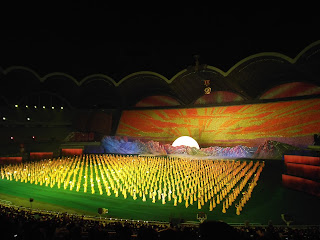Arirang, a spectacular of mass-coordinated dance, gymnastics and music, 100,000-strong in performers alone, is an annual event in Pyongyang and a highlight of any visit there during the summer months in which it takes place.
The May Day National Stadium, home to the festival, is a giant venue, the roof of the circular stands formed by a continuous concrete structure that looks like a giant clam shell turned upside down. The moment we arrived, we could feel the energy of the performance. Soldiers on their way in to the stadium marched briskly in formation, singing in unison as they went.
We walked up the steps. Usually, when entering a stadium, you can see the fans in the stand on the opposite side. Here, we saw the brightly-coloured display of the thousands of children holding up cards in coordination as they would continue to do throughout the evening, producing propaganda, cartoons, patterns, the leaders' portraits, war scenes and innumerable other things.
The sheer improbability of the performance itself, its numbers, the gymnastics, the acrobatics, the music, the dancing and the movement, was astonishing. It started with a traditional Korean love story (which gives the festival the name "Arirang"), before giving the local version of the history of the Korean War, included in this year's performance due to it being 65 years since the ceasefire - or "victory" as the North Koreans know it. Then there were children skipping or dancing with hoops and on unicycles; gymnastics with materials in coordinated colours providing large-scale props and landscapes such as crashing waves; and trapeze artists performing stunts from the height of the stadium itself.
Every colour imaginable was involved. The music, played by a brass band (it may have been a recording), went from pompous to patriotic to stirring. Each new act started with a fresh burst of energy and colour that was in direct correlation with the output of each individual performer.
The finale was a nationalistic depiction of a reunited Korea, the propaganda in full flow, the slogans in the background pounding the message home. The full meaning was lost on me. The visual impact was not. Somersaults, dance, light, flags and arms moving to create a sea, a tide on the vast stage. This is probably the closest I can come to describing Arirang, for it is a visual spectacular, not one designed for words, and one without comparable equivalent in any place outside this strange land of North Korea.
The May Day National Stadium, home to the festival, is a giant venue, the roof of the circular stands formed by a continuous concrete structure that looks like a giant clam shell turned upside down. The moment we arrived, we could feel the energy of the performance. Soldiers on their way in to the stadium marched briskly in formation, singing in unison as they went.
We walked up the steps. Usually, when entering a stadium, you can see the fans in the stand on the opposite side. Here, we saw the brightly-coloured display of the thousands of children holding up cards in coordination as they would continue to do throughout the evening, producing propaganda, cartoons, patterns, the leaders' portraits, war scenes and innumerable other things.
The sheer improbability of the performance itself, its numbers, the gymnastics, the acrobatics, the music, the dancing and the movement, was astonishing. It started with a traditional Korean love story (which gives the festival the name "Arirang"), before giving the local version of the history of the Korean War, included in this year's performance due to it being 65 years since the ceasefire - or "victory" as the North Koreans know it. Then there were children skipping or dancing with hoops and on unicycles; gymnastics with materials in coordinated colours providing large-scale props and landscapes such as crashing waves; and trapeze artists performing stunts from the height of the stadium itself.
Every colour imaginable was involved. The music, played by a brass band (it may have been a recording), went from pompous to patriotic to stirring. Each new act started with a fresh burst of energy and colour that was in direct correlation with the output of each individual performer.
The finale was a nationalistic depiction of a reunited Korea, the propaganda in full flow, the slogans in the background pounding the message home. The full meaning was lost on me. The visual impact was not. Somersaults, dance, light, flags and arms moving to create a sea, a tide on the vast stage. This is probably the closest I can come to describing Arirang, for it is a visual spectacular, not one designed for words, and one without comparable equivalent in any place outside this strange land of North Korea.














